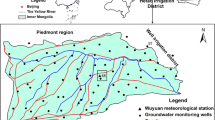Abstract
Water is a vital resource for agricultural crop production in the Texas Panhandle. This semi-arid region relies almost solely on the Ogallala Aquifer as the primary source of water. Agricultural production dominates water use in the area and is projected to account for 92% of total water use by 2020. Since agriculture is such an essential sector of the regional economy, prolonging irrigation capability through improvements in crop production methods is warranted. The area of concern and evaluation in this study consists of Texas’ northernmost 21 counties where groundwater withdrawal rates continue to exceed the aquifer’s recharge rate, resulting in less available irrigation resources. Within the region, seven counties in the Panhandle Water Planning Area of Texas are projected to incur water shortages in the 2020–2070 planning horizon. A regional analysis evaluating several agricultural water conservation strategies and combinations to address the decline of water use in the region is presented. The analysis examines potential water savings and implementation costs associated with the alternative strategies to provide useful information to stakeholders such as producers, groundwater conservation districts, and regional water planning groups.

Similar content being viewed by others
References
Almas L, Bretz F, Amosson S, et al (2000) Water management strategies for reducing irrigation demands in region A. Panhandle water planning project Task 5 Report. Texas A&M University, Agricultural Research and Extension Center, Amarillo, TX, July pp. 31
American Society of Farm Managers and Rural Appraisers (2018) Texas rural land value trends 2017
Amosson S, Almas L, Girase J, et al (2011) Economics of irrigation systems B-6113. Amarillo, Texas
Amosson S, Guerrero B, Dudensing R (2015) The impact of agribusiness in the high plains trade area. https://agrilifecdn.tamu.edu/amarillo/files/2010/11/2015-Agribusiness-Brochure.pdf. Accessed 3 June 2019
Amosson S, Almas L, Guerrero B, et al (2017) Texas crops and livestock budgets, Texas High Plains Projected for 2018
Chen Y, Marek G, Marek T, Gowda P, Xue Q, Moorhead J, Brauer D, Srinivasan R, Heflin K (2019) Multisite evaluation of an improved SWAT irrigation scheduling algorithm for corn (Zea mays L.) production in the US Southern Great Plains. Environ Model Softw 118:23–34
Conservation Technology Information Center (2014) Tillage type definitions. https://www.ctic.org/resource_display/?id=322. Accessed 3 June 2019
Epplin F, Stock C, Kletke D, Peeper T (2005) Cost of conventional tillage and no-till continuous wheat production for four farm sizes. J ASFMRA (AmSoc Farm Manag Rural Apprais). https://doi.org/10.22004/ag.econ.190714
Freese and Nichols, Inc (2006) Regional Water Plan for the Panhandle Water Planning Area. Prepared for the Panhandle Water Planning Group, Amarillo, TX. Appendix Q. http://www.panhandlewater.org/2006_reg_plan.html. Accessed 20 May 2019
Freese and Nichols, Inc (2016) Regional Water Plan for the Panhandle Water Planning Area. Prepared for the Panhandle Water Planning Group, Amarillo, TX. Volume I. https://www.twdb.texas.gov/waterplanning/rwp/plans/2016/index.asp. Accessed 20 May 2019
Guerrero B, Amosson S, Nair S, Marek T (2017) The Importance of regional analysis in evaluating agricultural water conservation strategies. J Reg Anal Policy 47:188–198
Hao B, Xue Q, Marek T, Jessup K, Hou X, Xu W, Bynum E, Bean B, Colaizzi P, Howell T (2019) Grain yield, evapotranspiration, and water use efficiency of maize hybrids differing in drought tolerance. Irr Sci 37:25–34
Hornbeck R, Keskin P (2014) The historically evolving impact of the ogallala aquifer: agricultural adaptation to groundwater and drought. Am Econ J Appl Econ 6:190–219. https://doi.org/10.1257/app.6.1.190
Howell TA (1996) Irrigation scheduling research and its impact on water use. In: Camp CR, Sadler EJ, Yoder RE (eds) Evapotranspiration and irrigation scheduling, Proceedings of the International Conference, Nov. 3–6, 1996, San Antonio, TX. American Society of Agricultural Engineers, St. Joseph, MI
Luedeker B (2016) Benefits of conservation tillage discussed at Field Crops Tour. https://soilcrop.tamu.edu/newsletters_bulletins/aggie_agenda/AggieAgendaJuly16.pdf. Accessed 1 Sept 2019
Marek T, Amosson S, Almas L, et al (2005) Feasibility of water management strategies for the declining ogallala aquifer. In: ASCE—EWRI World Water and Environmental Resources Congress, Anchorage, AK, May
Marek T, Porter D, Howell T (2005) The Texas high plains evapotranspiration network—an irrigation scheduling technology transfer tool. Final report for Contract #2004-358-008, TWDB, Austin, TX pp 16
McGuire VL (2017) Water-level and recoverable water in storage changes, High Plains Aquifer, predevelopment to 2015 and 2013–15. Reston, VA
North Plains Groundwater Conservation District (2019) The master irrigator program. http://northplainsgcd.org/conservationprograms/communityedu/master-irrigator/. Accessed 15 Aug 2019
Panhandle Water Planning Group (2016) Panhandle Regional Water Plan. Amarillo, Texas
Texas Water Development Board (2014) Regional water planning area a—panhandle. http://www.twdb.texas.gov/mapping/doc/maps/rwpg/RWPA_A_8x11.pdf Accessed 1 Sep 2019
Texas Water Development Board (2019) 2021 Regional and 2022 State Water Plan Projections Data. http://www.twdb.texas.gov/waterplanning/data/projections/index.asp. Accessed 27 May 2019
USDA (2018) Farm Service Agency Crop Acreage Data 2016–2018. https://www.fsa.usda.gov/news-room/efoia/electronic-reading-room/frequently-requested-information/crop-acreage-data/index Accessed 11 Oct 2018
USDA (2020) Farm Service Agency Conservation Reserve Program. https://www.fsa.usda.gov/programs-and-services/conservation-programs/conservation-reserve-program/ Accessed 10 Jul 2020
Zhao J, Xue Q, Jessup K, Hao B, Hou X, Marek T, Xu W, Evett S, O’Shaughnessy S, Brauer D (2018) Yield and water use of drought-tolerant maize hybrids in a semiarid environment. Field Crops Res 216:1–9
Acknowledgements
This research was supported in part by the Ogallala Aquifer Program, a consortium of the USDA Agricultural Research Service, Kansas State University, Texas A&M AgriLife Research, Texas A&M AgriLife Extension Service, Texas Tech University, and West Texas A&M University. A portion of funding for this research was also provided by USDA to Project No. 2016-68007-25066, through the National Institute for Food and Agriculture’s Agriculture and Food Research Initiative, Water for Agriculture Challenge Area. Project website: ogallalawater.org.
Funding
The funding sponsors had no role in the design of the study, analysis or interpretation of data, in the writing of the manuscript, or in the decision to publish the results.
Author information
Authors and Affiliations
Corresponding author
Ethics declarations
Conflict of interest
The authors declare no conflict of interest.
Additional information
Publisher's Note
Springer Nature remains neutral with regard to jurisdictional claims in published maps and institutional affiliations.
Rights and permissions
About this article
Cite this article
Crouch, M., Guerrero, B., Amosson, S. et al. Analyzing potential water conservation strategies in the Texas Panhandle. Irrig Sci 38, 559–567 (2020). https://doi.org/10.1007/s00271-020-00691-2
Received:
Accepted:
Published:
Issue Date:
DOI: https://doi.org/10.1007/s00271-020-00691-2




